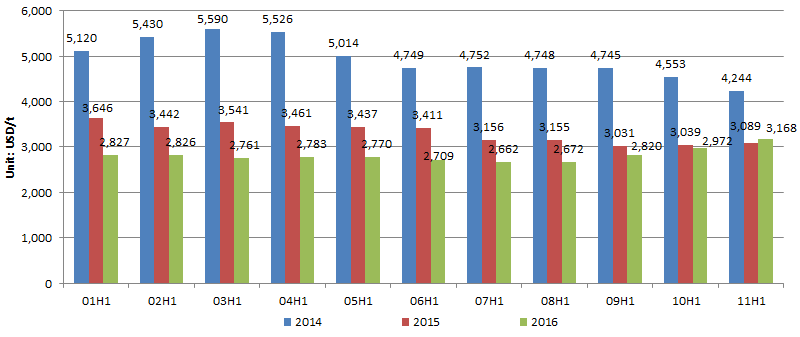After
a long period of declining glyphosate prices in China, the current season
strengthens the confidence for increasing prices. The main factors can be found
in boosting prices of raw materials like glycine and paraformaldehyde and
increasing downstream demand. This is what traders and buyers have to expect.

Source: Pixabay
In
the middle of November, the ex-works prices of glyphosate TC and glyphosate
formulations experienced another rise compared to the last month. The price
itself is remaining on a low level compared to previous years’ development, but
the continuous price rise shows the trend back up. The prices of glyphosate
technical started to rise in August 2016 and are suspected to continue to rise
also in December, according to CCM’s analysts.
Ex-works price of glyphosate technical, January – November 2014 - 2016

Source: CCM
The
main reason for the recently steady growth of glyphosate price and the expected
increasing trend, is the higher price of the raw materials for glyphosates like
glycine and paraformaldehyde. Their prices are rising, due to production cuts
by governmental orders and supply difficulties in the big snowing winter of
China’s north. In fact, 70% of the glyphosate production is based on the
glycine process, which requires glycine and paraformaldehyde. Glycine price
itself experienced a month on month fall from January to September 2016. Only
recently in November, the price climbed remarkably on a 22.45% MoM basis.
The
Hebei Province in China is the most important region for glycine and
paraformaldehyde producers, with the biggest output of those, accounting for
more than half of China’s national total output. This province is also affected
by huge pollution problems. Many days endured strong pollution in different
Cities of Hebei. As a result, the Ministry of Environmental Protection ordered,
that the production of several industry sectors must be cut down. These
implementations will prospectively end on 31 December 2016. Therefore, many
producers of glycine and paraformaldehyde have reduced their operating rate,
which in turn increases the prices due to lower supply and shortage. The
leading glycine producers in China, Shijiazhuang Donhua Jiniong, and Linyi
Hongtai, already rose their prices for glycine, which represents a trend that
is going to be continued, according to CCM.
Ex-works
prices of raw materials and intermediates for glyphosate in China, October –
November 2016

Source: CCM
The
winter in China has two main effects on the glyphosate price at all. First of
all, winter is known to be the storage peak season for glyphosate, while many
manufacturers only have small quantities of inventories. This higher demand in
building a storage is driving prices upwards. Another impact is the heavy
snowfall in northern China. The snow causes difficulties in transportation,
which also leads to a shortage of raw materials and therefore a higher price of
upstream and downstream products. Paraformaldehyde is especially affected by
this issue. China’s leading suppliers of paraformaldehyde, Hebei Jin Taida and
Hebei Aerospace, both with an output of about 50,000 tons, had to cut down
production completely, due to the region’s logistics and transportation being
blocked.
Other
upstream products of glyphosate, like yellow phosphorus and methyl alcohol,
experienced increasing prices up to 30% because of increased coke prices in
November, which are traditionally caused by the heating season in China’s cold
north. The increasing coke prices, up to 200% compared to early 2016, lead to
higher prices of raw materials in China in general.

Who
will be the beneficiaries of the rising glyphosate prices? Higher prices are
favoring the vendors and industry leaders, such as Sichuan Fuhua, Hubai Taisheng,
and Yangnong Chemicals. According to the multiple factors of glyphosate price
developing, it can be expected that the price is going to rise at about 20% to
30% soon.
What’s
more, in mid of October the 2016 AgriChemEx was held in Shanghai, with all the
main Chinese pesticide manufacturers as exhibitors. But what was surprising
was, that not one of them did any price quotation at the exhibition. In the
beginning of November, several enterprises have already raised the quotations,
which led to a stable market for glyphosate by now. The increasing demand of
the northern hemisphere, that is taking place right now, will likely affect
more price rising of glyphosate TC and formulations in the near future.
About
CCM:
CCM
is the leading market intelligence provider for China’s agriculture, chemicals,
food & ingredients and life science markets.
Do
you want to find out more about the glyphosate market in China? Join our
professional online platform today and get insights in Reports, Newsletter, and
Market Data at one place. For more trade information on pesticides visit our
experts in trade analysis to get your answers today.
Tags: glyphosate, pesticide, herbicide